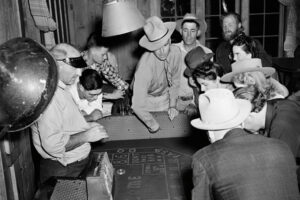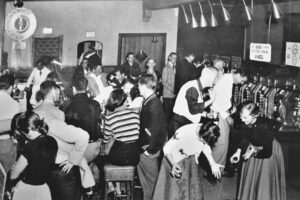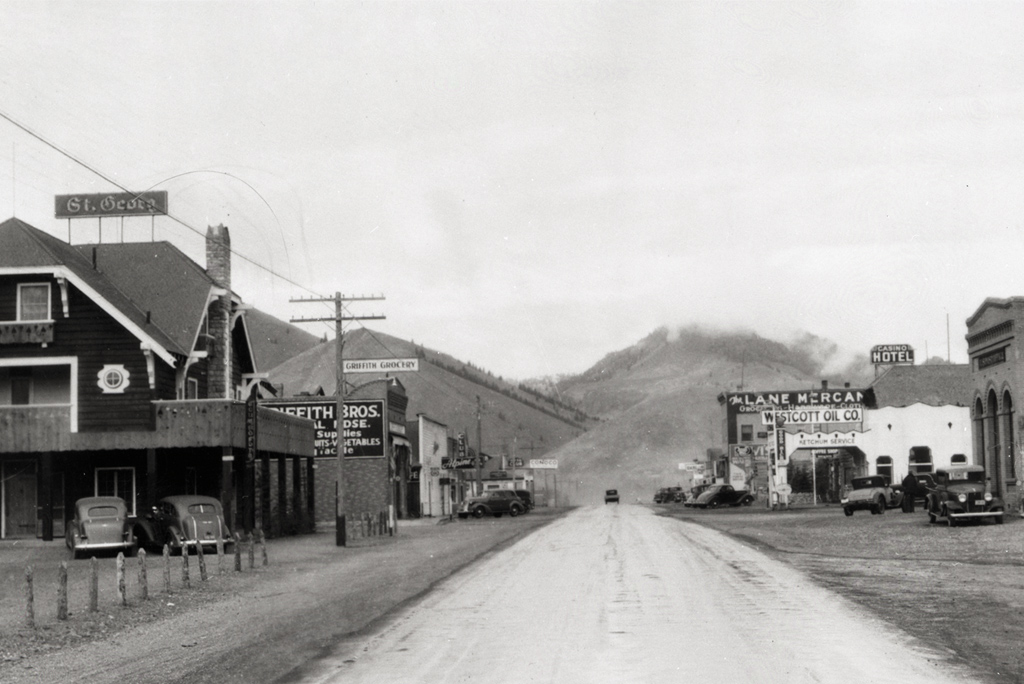Sun Valley was opened in December 1936 by Union Pacific Railroad, led by Averell Harriman, designed to restore rail passenger service that had “collapsed like a rotten trestle” during the Depression. Ski instructor Otto Lang said, “Sun Valley was a magnet for the ‘beautiful people,’ a meeting place for movie stars and moguls, chairmen and captains of industry, Greek shipping tycoons, and peripatetic playboys – and playgirls – of the international social set. All flocked to this wintery Shangri-la.”
Ketchum, a small, quiet mountain town, rapidly changed. Entrepreneurs set out to capture some of the wealth the resort’s clients brought to the area, where gambling was “tolerated,” although it was not strictly legal. A number of clubs and gambling establishments opened all over town that attracted Sun Valley’s wealthy guests, employees and locals. Clubs on Main Street included the Alpine, owned by Lou Hill, and the Sawtooth, owned by Owen Simpson. The Tram, the St. George Hotel and the Casino were all located south of Sun Valley Road; the Stockman’s Club, the Idaho Club, where the Pioneer Restaurant is now; and the Wooden Spur, where Sturtevants is now. Club Rio was on Leadville Ave., off Sun Valley Road.
One resort employee said the guests were wealthy, got good service, and “showed their appreciation with the green stuff.” Waiters often got a $20 tip for a $10 bill. “If you didn’t gamble, there wasn’t much to do,” and employees spent money “like it was going out of style.”

In the 1940s, Ketchum brought fast cars, strong booze and big poker hands, putting the newly-minted ski town “in a class with Reno…”
In December 1937, a high-end gambling establishment opened on Sun Valley Road, the Christiania Club, managed by Dutch Weinbrenner, allegedly a member of “Detroit’s Purple Gang,” giving rise to rumors that mob money was financing the “very up-town dinner club that brought a touch of class to gambling in Ketchum.” The food was good, the drinks were free and the resort offered high-stakes gambling, attracting the resort’s wealthier guests. Sun Valley publicist Dorice Taylor said it was “a favorite gathering spot for the Hollywood crowd in 1939…and everything was done in perfect taste…The big play at the tables was from the film colony.” Hollywood producer Darryl Zanuck allegedly lost $100,000 there one night.
The Christiania was closely tied to Sun Valley. Weinbrenner lived in a Lodge apartment. Arriving guests found invitations to the Club in their mailboxes. When guests wrote IOUs to cover their gambling losses, they were charged to their Sun Valley accounts.
In January 1939, Fortune magazine said, “After dinner, you may go down to Ketchum, where there are now more gambling houses than private homes.” A Sun Valley regular said the Tram, Alpine and Sawtooth Clubs offered drinking and gambling. Poker was played in the back, and roulette, blackjack and dice were played in the front. Many guests and locals played for high stakes. Sheepherders with large stacks of cash kept their sidearms on the tables. In February 1941, a Seattle Times reporter said the Christiania “outrivals any elaborate night club I’ve ever seen, including those in New York, Havana or Honolulu.”
During WWII, a naval rehabilitation hospital operated at Sun Valley. The Navy Commander told managers of the bars and clubs in Ketchum and the Red Light district in Hailey that Navy personnel could drink and gamble as long as they did not get drunk and the games were not crooked. If his rules were not followed, he would make their places off-limits. They got his message and followed his rules.
Jack Simpson, whose father owned the Sawtooth Club, said after WWII, five or six bars in Ketchum offering gambling were open all night.

The Casino built a steady, resonated following, and the ghosts of good times still linger.
Things didn’t really pick up in Ketchum until about 11:30 p.m. or 12:00 a.m. when things shut down in Sun Valley. All the guests and employees at Sun Valley would come to town and stay there until nearly daylight. It was a tough sort of group but also involved movie stars. Ketchum was full of movie stars, movie producers and other various important people. At that time, nobody paid attention to the movie crowd, and they were treated just like everyone else.
Ketchum had gambling clubs, and Hailey had prostitution. Casino-type gambling was popular in the 1930s and 1940s, and clubs offered blackjack, craps and wheel gambling games. There were no regular poker games, but poker was played in a number of locations.
In fall 1946, Ernest Hemingway returned to Sun Valley with a new wife, Mary Welsh, who said Sun Valley was a fashionable resort, but Ketchum was still a sentimentalist’s dream of the old West. Aged wooden sidewalks provided footpaths along the two blocks of Main Street. Most of the one-story brick or frame buildings held up innocently pretentious peaked false fronts another story high.
The Alpine Restaurant, where we devoured “sizzling steaks,”…was the town’s refuge for stomach hunger, and its adjoining bar and casino, where silver dollars clanked day and night at the poker and roulette tables, appeased other appetites. Ernest admired the Alpine…for its rule that drinks were on the house from the morning opening, about six o’clock, until 7 or maybe 8 a.m., thus enabling the town’s impecunious drunks to “get a hold on” themselves for the day. But he was also a patron of the Tram, a long, dank smelling bar on one side of the Alpine and its twin on the Alpine’s other flank, the -2- Sawtooth. Across the street was the Casino, offering booze, games of chance and light conversation.
In 1947, Idaho law changed to permit the sale of liquor by the drink, but on-site gambling was outlawed, and slot machines appeared. “From 1947 to 1953, one-armed bandits could be found on the outskirts of Idaho Falls, Pocatello and Garden City,” said a local newspaper. There were slot machines in Ketchum clubs, groceries and drug stores.
Sun Valley had slot machines in the Lodge’s lobby, the Challenger Inn had 14, and there were small portable slot machines guests could take to their rooms. Revenue from the resort’s bowling alley, pool tables and slot machines often totaled $41,000 a month, largely from the slots. Union Pacific did Sun Valley’s accounting and did not know about the gambling. When its accountants asked how it was possible to earn that much money from bowling and pool, General Manager Pat Rogers said, “It’s possible.”
In February 1948, the New York Times said Sun Valley was modern and glitzy, but Ketchum was an old-time western town where sheepherders and cattlemen mixed with skiers, celebrities and Hollywood stars. Winter sports enthusiasts imbibe such tasty Basque dishes as arroz con pollo, chorizos or patatas en salsa verde, and then…listen to the clanking of silver dollars in a slot machine, watch a spinning roulette wheel or follow the antics of expertly rolled dice.
The town’s gaming tables were “in a class with Reno…” Visitors find themselves dining or dancing beside the strikingly familiar outdoor enthusiasts customarily glimpsed only on the silver screen. Ralph Bellamy, Jane Russell, Ingrid Bergman, Gary Cooper, Daryl Zanuck, Ernest Hemingway, Dorothy Lamour and Phil Harris have all lent a cosmopolitan touch to such way stations along the ski trail as the Sawtooth Club and the Tram, where a former trainer of Jack Dempsey adds to the atmosphere.
The Idaho Legislature outlawed slot machines in 1953, ending Ketchum’s wide-open era. The Christiania closed, and Atkinson’s grocery store opened on the site.


